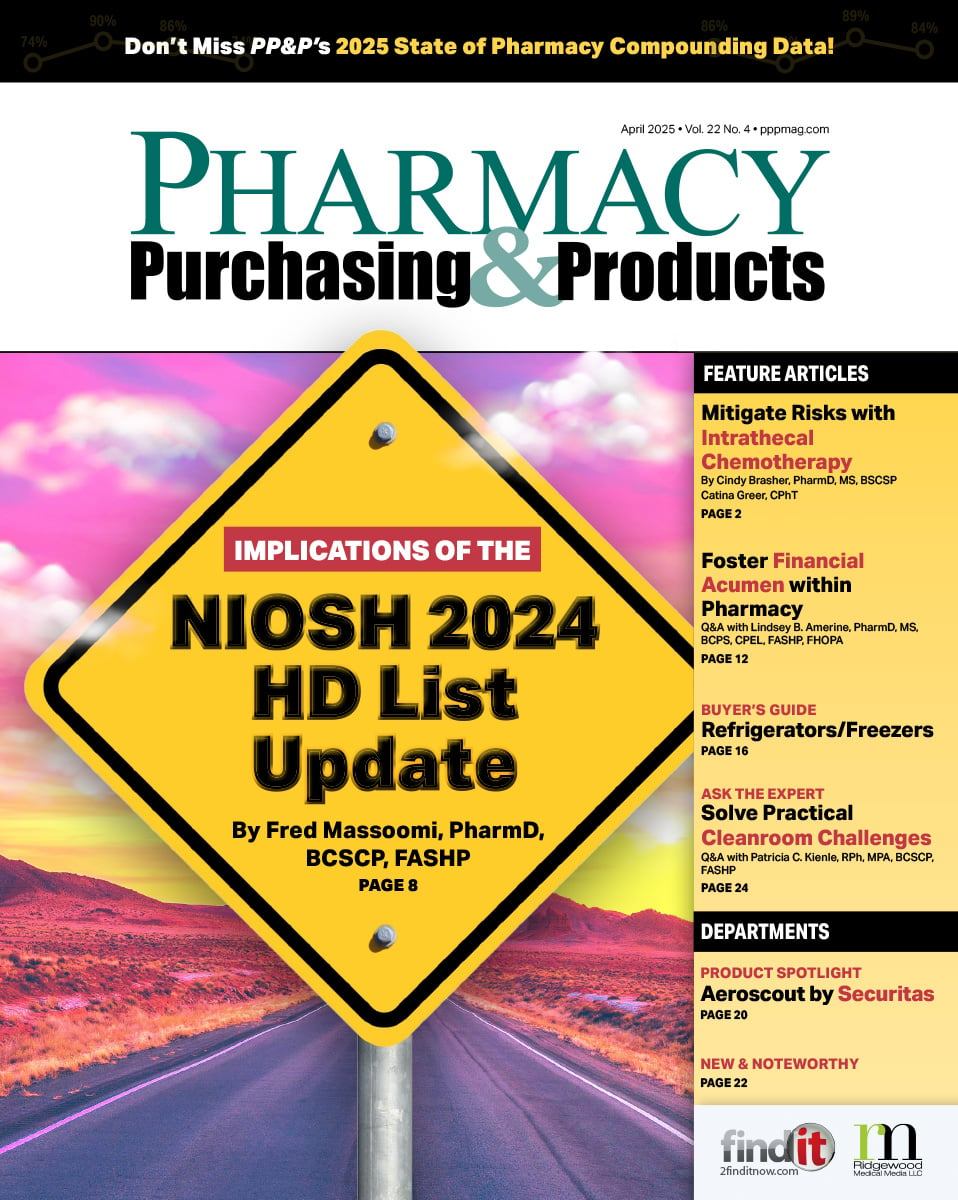- Show Menu
- Contact Us
- FAQs
- Reader Service
- Survey Data
- Survey Winners
- Testimonials
- Upcoming Events
- Webinars
- White Papers
Use of Commercially Available Parenteral Nutrition Products
The utilization of standardized, commercially available parenteral nutrition (PN) products to support the nutritional needs of patients who cannot receive oral diets is common in US health systems. These products, which provide protein, calories, and electrolytes, require minimal manipulation to prepare and have few stability and compatibility concerns. Standardized, commercially available PN products are a flexible, convenient solution for organizations providing PN to patients without compounding in-house.
Types of Products
PN can be sourced either as patient-specific customized products, institution-specific standardized formulations, or standardized commercially available products. Commercially available PN products are provided as two&ndashl or three-chamber formulations. The two-chamber products contain amino acids (with or without electrolytes) in one chamber and dextrose in the other chamber, and are available in amino acid concentrations ranging from 2.75% to 5% and in dextrose concentrations from 5% to 25%. The two-chamber formulation can be administered via the peripheral or central route, depending on the osmolarity of the formulation, and is available in 1 L or 2 L volumes. The three-chamber product contains amino acids with electrolytes in one chamber, dextrose in another chamber, and intravenous fat emulsion (IVFE) in the third chamber. This product has two formulations: one for peripheral administration and the other for central administration, and is available in four volumes, ranging from 1 L to 2.5 L.
The two– and three-chamber bags require the addition of multivitamins for injection and trace elements after they are activated for delivery of appropriate nutritional needs, and thus are not complete nutrition regimens. The 2014 American Society for Parenteral and Enteral Nutrition (ASPEN) PN Safety Consensus Recommendations state that these products should be activated, and any additional additives should be admixed, by the pharmacy under conditions specified in USP <797>, and recognize commercially available PN as a viable alternative to compounding for selected patients.1
Advantages of Commercially Available PN Products
Commercially available PN products provide multiple benefits to organizations, including minimal manipulation required prior to use, stability and compatibility benefits, a reduced risk for compounding errors, and less time commitment for compounding, while ensuring a reliable PN supply in the event of component shortages.2
- Minimal Manipulation Is Required. Two– and three-chamber PN products supply the major macronutrients, with or without electrolytes, in formulations that require minimal compounding by a pharmacist. This allows institutions with limited expertise and/or facilities for compounding to provide PN to appropriate patient populations.
- Few Stability and Compatibility Concerns. PN can be delivered safely to patients with minimal concerns regarding product stability and compatibility of the addition of electrolytes, trace elements, and vitamins.
- Safety Benefits. Organizations that utilize standardized, commercially available PN can have peace of mind that these products have been compounded in a compliant environment and are error-free. Moreover, order interpretation and transcription errors are eliminated with the use of these products.
- Reduced Time Commitment. Use of commercially available PN products in non-complicated patients requires limited pharmacist and/or pharmacy technician time for compounding. However, institutions should take care not to treat these products as benign; clinical evaluation by a multidisciplinary nutrition support team is required.
- Impact of Drug Shortages Is Mitigated. Standardized, commercially available PN products are a reliable source for the prescription of PN during national product shortages. With limited allotment of electrolytes due to shortages, standardized, commercially available PN offers an alternative available with predetermined electrolyte profiles. This can allow for proper allotment of electrolytes to patients who are in critical need (eg, pediatric and critically ill patients, emergency situations).
Product Limitations
Although there are many benefits to using commercially available PN products, certain limitations must be addressed, including their lack of acceptability for all patients and the possibility of waste.2
- Fixed Amounts Preclude Use By Some Patients. Multi-chamber PN products provide fixed amounts of micro– and macro-nutrients. Therefore, their use in certain patient populations, such as those with short-bowel, gastrointestinal fistulas, and hypercatabolic conditions, is limited. Treating patients with these conditions, and those with other conditions requiring increased amounts of protein and calories, may preclude the use of multi-chamber PN products. For these patients, volume overload may be an issue, and when using standardized, commercially available PN, there is no ability to concentrate overall PN volume.
The use of standardized, commercially available PN also may be limited in patients with severe electrolyte abnormalities and renal failure. Ideally, all standardized, commercially available PN products would be available in an electrolyte-free formulation, which would allow for the addition or elimination of electrolytes as needed. However, no electrolyte-free formulation is currently available from any manufacturer.
- The Potential for Waste. The delivery of optimized nutrition therapy with standardized, commercially available PN may result in product waste in certain scenarios. For example, some patients may require slightly more than a 1 L bag; the remainder of the 2 L bag must then be wasted.
Staff Education and Training
Organizations that utilize standardized, commercially available PN products must adequately educate nursing staff who will be administering PN. These practitioners should be knowledgeable about how the bags look when they are admixed, which port to access, and must understand how to reconcile PN labels to PN orders.3 After implementing these products, institutions must review PN use for errors or potential breakdowns in the process with staff on a regular basis. In addition to nurse training, pharmacists also must be adequately trained regarding sterile preparation of standardized, commercially available PN. Proper sterile technique is vital to maintaining an uncontaminated product, especially considering that the port often must be accessed multiple times to mix in all required additives. Staff should exercise caution when adding additional electrolytes to these regimens, and should consult the manufacturer for details regarding the addition of any components.
Finally, the “premixed” nomenclature often used when referring to standardized, commercially available PN can lead practitioners to believe that because minimal preparation of the PN is required, these products are without risk. However, it is vital to remember that these solutions are complex medications that can, and have, caused patient harm when used inappropriately. A culture of safety must ultimately prevail throughout the entire medication-use process, including when using commercially available PNs.
References
- Ayers P, Adams S, Boullata J, et al. A.S.P.E.N. parenteral nutrition safety consensus recommendations. JPEN J Parenter Enteral Nutr. 2014;38(3):296-333.
- Gervasio J. Compounding vs standardized commercial parenteral nutrition product: pros and cons. JPEN J Parenter Enteral Nutr. 2012;36(suppl 2):40S-41S.
- Boullata JI, Holcombe B, Sacks G, et al. Standardized competencies for parenteral nutrition order review and parenteral nutrition preparation, including compounding: the ASPEN model. Nutr Clin Pract. 2016;31(4):548-555.

Phil Ayers, PharmD, BCNSP, FASHP, is a clinical specialist in nutrition support and chief of clinical pharmacy services in the department of pharmacy at Baptist Health Systems in Jackson, Mississippi. He serves as secretary-treasurer for the board of directors of ASPEN, and is the current president of the Mississippi Pharmacists Association. Phil received his BS in pharmacy and his PharmD from the University of Mississippi.

Andrew Mays, PharmD, is a clinical pharmacy specialist at Mississippi Baptist Medical Center and is a clinical assistant professor at the University of Mississippi School of Pharmacy. He serves as president-elect for the Mississippi Society of Health-System Pharmacists and president of the Mississippi Society for Parenteral and Enteral Nutrition. Andrew received his PharmD from the University of Mississippi.
Jenny Anderson, MS, RD, LD, CNSC, is a registered dietitian at Baptist Health Systems in Jackson, Mississippi. She completed her undergraduate degree in nutrition and dietetics at the University of Southern Mississippi and obtained her Masters Degree from the University of Alabama.
RESOURCES BOX
Additional PN Resources
Biesboer AN, Stoehr NA. A product review of alternative oil-based intravenous fat emulsions [published online ahead of print August 15, 2016]. Nutr Clin Pract. pii: 0884533616661174.
Boullata JI, Gilbert K, Sacks G, et al. A.S.P.E.N. clinical guidelines: parenteral nutrition ordering, order review, compounding, labeling, and dispensing. JPEN J Parenter Enteral Nutr. 2014;38(3):334-377.
McClave SA, Taylor BE, Martindale RG, et al. Guidelines for the provision and assessment of nutrition support therapy in the adult critically ill patient: Society of Critical Care Medicine (SCCM) and American Society for Parenteral and Enteral Nutrition (A.S.P.E.N.). JPEN J Parenter Enteral Nutr. 2016;40(2):159-211.
CASE STUDY
Use of Commercially Available PN Products at MBMC
Mississippi Baptist Medical Center (MBMC), a 530-bed facility located in Jackson, has an average daily adult PN census of twelve patients. Commercially available PN products have been utilized for over 5 years at MBMC, and the majority of patients who require PN receive these products. All PN patients are managed by MBMC’s multidisciplinary nutrition support service.
We primarily utilize two-chamber systems with the addition of intravenous fat emulsions (IVFEs) to the multi-chamber bag. Three formulations are available on formulary:
- Peripheral Use: A 2.75% amino acid with 5% dextrose product is available
- Central Administration: A 5% amino acid with 15% dextrose with electrolytes product and a 4.25% amino acid with 10% dextrose without electrolytes product are available
The product without electrolytes is primarily used in patients who require customization for electrolyte abnormalities. All PN products are ordered using the electronic health record (EHR) computerized prescriber order entry function.
Use of standardized, commercially available PN products was initiated following a recall of the automated compounding device (ACD) utilized in the pharmacy department. A few additional issues prompted implementing use of commercially available PN products:
- The Cost of ACD Equipment. The ongoing costs of transfer sets, mixing containers, and other required equipment for the ACD can lead institutions to seek alternatives
- PN Component Availability. In recent years, multiple PN components have been in short supply, complicating in-house PN compounding
PN compounding is performed when required at MBMC on a limited basis. Unfortunately, the ACD has not been replaced; thus, compounding is performed via the gravity method. To ensure safety, pharmacy utilizes PN software to check for issues regarding compatibility and stability. Due to the complexity of these modalities, PN is compounded by pharmacists.
The following limitations have been encountered when using commercially available PN products:
- Patients with electrolyte abnormalities require additional boluses and/or the addition of electrolytes to maintenance fluids
- Patients requiring protein in amounts >1.5 g/kg (eg, patients with fistula or receiving continuous renal replacement therapy)
- Fluid-restricted patients
- Patients requiring volumes greater than 2 L to achieve nutritional goals
Future plans for PN management include reinstatement of an ACD with functionality to facilitate communication with the EHR to minimize transcription errors, which are among the most common errors that occur in the PN process. Nonetheless, the nutrition support service will continue utilizing commercially available PN products in selected patients. Newer IVFEs have been approved for use in the US, and multi-chamber formulations containing these alternative fats could be on the horizon. Products containing IVFEs hold promise for critically ill and immunocompromised patients, and therefore, plans are underway for the addition of alternative IVFEs to the formulary.
Like what you've read? Please log in or create a free account to enjoy more of what www.pppmag.com has to offer.








